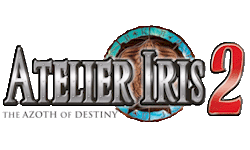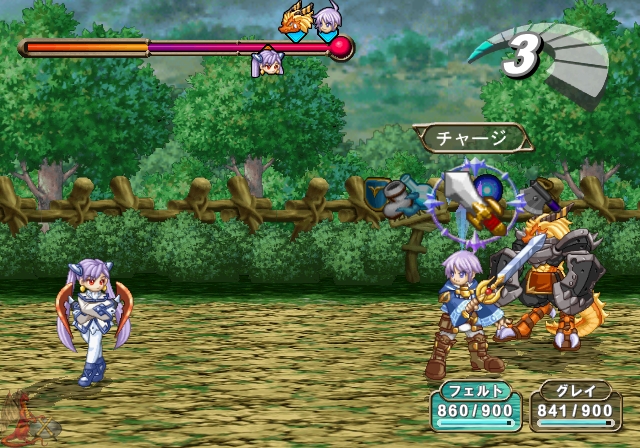|
|

|
BATTLE SYSTEM
|

|
INTERACTION
|

|
ORIGINALITY
|

|
STORY
|

|
MUSIC & SOUND
|

|
VISUALS
|

|
CHALLENGE
|
Very Easy
|
COMPLETION TIME
|
35-50 Hours
|
|
OVERALL
4.0/5
|
Rating definitions
|
|
|
For several centuries, the floating continent of Eden has been a peaceful paradise for humans and Mana Spirits. However, several parts of Eden have begun disappearing, and a boy named Felt parts ways with his friend Viese after a gate to the land of Belkhyde opens, with Felt seeking a way to restore his vanishing world. Atelier Iris 2: The Azoth of Destiny, developed by Gust and published in North America by Nippon Ichi, is a solid sequel sure to please fans of the original.
Atelier Iris 2's battle system bears many improvements over that of its predecessor. First, a gauge in the lower-left side of the screen changes colors from blue to red to indicate how close the player is to encounter enemies during exploration, and after each battle, part of the gauge depletes. Each room or hall of a dungeon has a separate gauge, which, when fully depleted, means the player won't encounter any more monsters in that particular room or hall. These gauges, however, reset when a player enters the party's camp via a glowing red portal (which fully restores the party and allows for saving and Item Synthesis) or exits the dungeon.
Battles themselves are turn-based, with a speed gauge at the top of the screen showing turn order, with icons indicating your characters and the enemy simultaneously moving to the right side of the gauge, and whoever reaches the end taking his or her turn. Once one of your characters reaches the end of the gauge, he or she can execute a command, which includes two different kinds of normal attacks: charge attacks and break attacks. Charge attacks gradually fill up the skill gauge in the upper-right of the screen, which can increase up to ten levels, and defaults to one level at the beginning of all fights, while break attacks push an enemy back on the speed gauge yet don't fill up the skill gauge.
 Boy and Dragon vs. Praying Mantis Girl
Boy and Dragon vs. Praying Mantis Girl
|
|
When the player has pushed an enemy back far enough on the speed gauge with break attacks, all attacks against the enemy party, as long as the "broken" enemy remains in the orange area of the gauge, will form a chain combo, which can allow for massive bonuses in experience and skill points after the battle has ended. Each character can also use special skills, which consume up to three levels of the skill gauge. Moreover, characters can use Mana Items, change places with another ally not in the party, escape, or defend.
As in the first game, Mana Synthesis plays an important role in combat. Both Viese and Felt, respectively in Eden and Belkhyde, can absorb Mana from various sources that the player can use to create Mana Items. Before a player can create a Mana Item with Mana, however, Viese must first create that item with recipes (found from chests or bought from shops) and raw material, which the player can also use to create accessories and alchemy items (both of which the player can't create with Mana).
Each character can equip up to two accessories and two alchemy items, with alchemy items allowing characters to gradually learn various innate skills with effects such as increased attack power and increased maximum HP through skill points acquired from combat. Skill points also allow characters to gradually learn new special skills to use in battle from their weapons, which are upgradable to more powerful forms with Mana Spirits and items.
 Mikel Tidwell finally realizes his dream
Mikel Tidwell finally realizes his dream
|
|
Given the ease of acquiring experience bonuses, the ability of any character to use Mana Items, and the increased quantity of Mana Items players can carry into combat, Atelier Iris 2 is significantly easier than the first; I managed to beat it without getting a single Game Over screen, with only the extra arena fights and last boss posing significant threats. Full marks do go to the developers, though, for creating a fast, solid battle system with enough features in and out of combat to prevent players from falling asleep.
The interface of Atelier Iris 2 is spotless for the most part, despite some minor lags when navigating the menus. The overworld is much simpler this time around, consisting of a few dot-connected maps similar to those in Final Fantasy Mystic Quest and Legend of Dragoon (and free of random encounters). One interesting feature is the availability of a Mana Item that allows players to see how many chests, breakable rocks, and so forth, are in each dungeon they've visited. The translation does contain some minor errors and the occasional text flowing beyond textboxes, but otherwise, Atelier Iris 2 is very user-friendly.
Atelier Iris 2, however, is a fairly derivative RPG. Not only does it filch elements from its predecessor, such as certain gameplay mechanisms and its visuals, it also pilfers ideas from other RPGs, such as the Grandia games (the speed gauge and two kinds of normal attacks), Legend of Dragoon (the encounter indicator), Riviera: The Promised Land (the skill system in battle), and Final Fantasy IX (learning skills from items). The only major innovation is the ability of dungeon rooms to "run out" of random encounters, but otherwise, seasoned RPGamers are sure to notice the game's derivative disposition.
 "What do you mean you crucified that girl?"
"What do you mean you crucified that girl?"
|
|
The story is a little better than that in the original Atelier Iris, although that's no accomplishment. The plot is somewhat stereotypical, involving things such as an evil empire, a mysterious paradise, a sword in a stone, a character with amnesia, and so forth, although there are a few decent twists, and the cast is reasonably endearing, with some humor occasionally injected into the mix (the music can somewhat enhance the humor at times). Still, the story certainly isn't the strongest reason the play the game.
Atelier Iris 2 features a style of music very similar to that of its predecessor, with a nice variety of folk music and rocky battle themes. There are some fairly humorous pieces, as well, such as one of the shopping themes and a certain piece that plays during comical cutscenes. The voice acting is largely hit-or-miss, though, and there are some minor audio glitches, but otherwise, a decent-sounding game.
The visuals in Atelier Iris 2 largely mimic those of its predecessor, minus a hideous overworld, and plus a few decent anime cutscenes throughout the game. The sequel relies on sprites and still scenery to do the job, not to mention still anime portraits during many cutscenes, all decently in design. Battle graphics contain reasonable animation, flashy effects, and realistic shadows, albeit with some choppiness. Even so, Atelier Iris 2 is still one of the best-looking 2-D RPGs on the Playstation 2.
Finally, players can blaze through Atelier Iris 2 in as little as thirty-five hours, or spend around fifty hours on the post-game arena battles, which can require some stat-building, although there are some tricks for easier triumph. Overall, Atelier Iris 2 is largely what a sequel should be, improving upon its predecessor in virtually every way while throwing in good elements from other RPGs. Fans of the original are sure to enjoy the sequel, and even newcomers to Gust's series might find some enjoyment, as well.
Review Archives
|









